| dc.contributor.author | Esmaeeli, Zahra | |
| dc.contributor.author | Lundetræ, Kjersti | |
| dc.contributor.author | Kyle, Fiona | |
| dc.date.accessioned | 2023-01-11T12:11:26Z | |
| dc.date.available | 2023-01-11T12:11:26Z | |
| dc.date.created | 2017-09-18T16:52:29Z | |
| dc.date.issued | 2017 | |
| dc.identifier.citation | Esmaeeli, Z., Lundetræ, K., & Kyle, F. E. (2018). What can parents' self‐report of reading difficulties tell us about their children's emergent literacy at school entry?. Dyslexia, 24(1), 84-105. | en_US |
| dc.identifier.issn | 1076-9242 | |
| dc.identifier.uri | https://hdl.handle.net/11250/3042699 | |
| dc.description.abstract | Research has linked family risk (FR) of reading difficulties (RD) with children's difficulties in emergent literacy development. This study is the first to apply parents' self-report of RD as a proxy for FR in a large sample (n = 1171) in order to test group differences in children's emergent literacy. Emergent literacy, the home literacy environment and children's interest in literacy and letters were compared across different groups of FR children around the school entry. The FR children performed lower in emergent literacy compared with not-FR children. Furthermore, when comparing FR children with one parent reporting RD and children with both parents reporting RD, moderate group differences were found in Emergent Literacy. Finally, parents' self-report of RD was a significant contributor of emergent literacy after controlling for the home literacy environment, children's gender, their interest in literacy and letters, months in kindergarten, vocabulary and parents' education. Our findings suggest that schools should monitor the reading development of children with parents self-reporting RD closely – especially if both parents self-report RD | en_US |
| dc.language.iso | eng | en_US |
| dc.publisher | Wiley | en_US |
| dc.rights | Navngivelse 4.0 Internasjonal | * |
| dc.rights.uri | http://creativecommons.org/licenses/by/4.0/deed.no | * |
| dc.title | What can Parents’ Self-report of Reading Difficulties Tell Us about Their Children’s Emergent Literacy at School Entry? | en_US |
| dc.type | Peer reviewed | en_US |
| dc.type | Journal article | en_US |
| dc.description.version | publishedVersion | en_US |
| dc.rights.holder | The authors | en_US |
| dc.subject.nsi | VDP::Samfunnsvitenskap: 200 | en_US |
| dc.source.journal | Dyslexia | en_US |
| dc.identifier.doi | 10.1002/dys.1571 | |
| dc.identifier.cristin | 1494976 | |
| dc.relation.project | Norges forskningsråd: 237861 | en_US |
| cristin.unitcode | 217,6,6,0 | |
| cristin.unitname | Nasjonalt senter for leseopplæring og leseforsking | |
| cristin.ispublished | false | |
| cristin.fulltext | postprint | |
| cristin.qualitycode | 2 | |

